How Much Snow Can Roofs Hold? A Comprehensive Guide to Understanding Snow Load and Roof Safety
Winter brings a picturesque landscape of snow-covered homes and rooftops, but with this beauty comes the potential for significant structural challenges. Snow can accumulate on your roof over the course of a winter storm, and in some cases, the weight of the snow can put your roof at risk of damage or even collapse. Understanding how much snow a roof can safely hold is crucial for homeowners who live in areas prone to heavy snowfall. In this comprehensive guide, we’ll explore the factors that determine how much snow your roof can bear, signs that your roof is under stress, and what to do if you’re concerned about snow accumulation on your roof.
Why is Snow Load a Concern?
Snow load refers to the weight of the snow and ice on your roof. This weight can vary greatly depending on the type of snow (light and fluffy versus wet and heavy) and the amount of snow that falls over time. While snow may seem light and fluffy at first, it can quickly accumulate into a significant weight that can place considerable stress on your home’s structural integrity.
When snow builds up on a roof, it can have several effects:
- Increased Weight Load: Heavy snow can add significant weight to the roof, especially if it accumulates over a prolonged period. This added weight can strain the structure of your roof and cause damage to the roofing materials, insulation, and even the building’s frame.
- Roof Collapse: In extreme cases, excessive snow accumulation can cause a roof to collapse. This is more likely to happen if the snow is heavy and wet, or if the roof structure is already weakened by age, poor maintenance, or pre-existing damage.
- Water Damage: As snow melts, it can leak into your home, causing water damage to ceilings, walls, insulation, and flooring. If snow is left to accumulate on the roof for too long, it can also create ice dams, further exacerbating the risk of water damage.
Knowing how much snow your roof can safely hold can help you take action to prevent these potential problems.
What Factors Affect How Much Snow Your Roof Can Hold?
There are several factors that influence the amount of snow your roof can hold. These factors include the type of snow, the design and age of your roof, and the materials used in construction. Let’s take a closer look at each of these factors.
1. Roof Design and Pitch
The design and pitch (angle) of your roof are some of the most important factors in determining how much snow it can hold. A roof with a steep pitch allows snow to slide off more easily, reducing the chance of snow accumulation. Conversely, flat or low-pitched roofs tend to hold more snow because there is less slope for the snow to slide off of.
Key Considerations for Roof Design and Pitch
- Steep Roofs: Steep-pitched roofs are generally better at handling snow accumulation because the snow tends to slide off rather than settle. A roof with a pitch of 45 degrees or more can shed snow effectively.
- Flat or Low-Pitched Roofs: Low-pitched or flat roofs are more prone to snow buildup. The weight of accumulated snow can place stress on the roof structure, especially if the snow becomes wet and heavy. Roofs with a pitch of 20 degrees or less are at a higher risk for snow accumulation.
2. Roof Material
The materials used in the construction of your roof can also impact its ability to support snow load. Some materials are stronger and more durable than others, allowing them to hold more weight without sustaining damage.
Common Roofing Materials and Their Strengths
- Asphalt Shingles: Asphalt shingles are one of the most common roofing materials. While they are relatively strong, they may not be as capable of withstanding heavy snow loads as other materials. The strength of asphalt shingles depends on the underlying structure of the roof and the shingles’ age and condition.
- Metal Roofing: Metal roofs are ideal for areas that receive heavy snow, as they are typically strong and durable. Additionally, metal roofs tend to shed snow more easily due to their smooth surface, reducing the risk of excessive accumulation.
- Wood Shakes and Shingles: Wood roofing materials are also strong but tend to absorb moisture over time, which can make them more prone to damage under heavy snow loads. They may also increase the risk of ice dams forming in colder climates.
- Tile and Slate Roofing: Tile and slate are among the heaviest roofing materials, and while they are durable, they can add weight to the roof, which should be factored into the snow load calculations. These materials are typically more suitable for warmer climates or roofs designed to bear the additional weight.
3. Roof Structure and Framing
The framing of your roof plays a major role in how much weight it can safely hold. Roof trusses or rafters are designed to bear a certain amount of weight, and overloading them with excessive snow can lead to structural failure.
Factors to Consider About Roof Structure
- Truss Spacing: Roof trusses are typically spaced 16 to 24 inches apart, and the amount of weight they can support depends on their design and spacing. If trusses are spaced too far apart or are poorly constructed, they may not be able to handle the weight of heavy snow.
- Roof Age and Condition: Older roofs or those that haven’t been properly maintained may have weakened framing or structural issues that reduce their load-bearing capacity. It’s important to regularly inspect your roof to ensure that it can handle the weight of snow.
4. Snow Type and Density
Not all snow is created equal. The weight of snow varies based on its moisture content and density. Light, fluffy snow is less dense and weighs less, while wet, heavy snow can be much more compact and heavy.
Snow Density and Weight
- Light, Fluffy Snow: On average, light, dry snow weighs about 5 to 8 pounds per cubic foot. This type of snow is less likely to cause structural damage and is easier for a roof to handle.
- Wet, Heavy Snow: Wet, dense snow can weigh as much as 20 pounds per cubic foot or more. If a large amount of heavy snow accumulates on your roof, it can quickly exceed the load-bearing capacity of the structure, leading to damage or collapse.
5. Geographic Location and Local Snowfall Patterns
The area where you live plays a crucial role in determining how much snow your roof needs to support. In regions that experience heavy snowfall, building codes are often more stringent to ensure that roofs are constructed to handle significant snow loads. In areas with lighter snowfall, roofs may be designed with less snow load capacity.
Building Codes and Snow Load Requirements
In the U.S., building codes are set by local jurisdictions and often take into account the average snowfall and snow load for the area. These codes provide guidelines for the minimum load-bearing capacity required for residential roofs.
For example, the International Residential Code (IRC) sets minimum snow load requirements based on geographic location. In areas with heavy snowfall, roofs are designed to withstand much greater snow loads than in regions where snow is infrequent or light.
How Much Snow Can a Roof Hold?
The amount of snow a roof can hold varies greatly depending on the factors we’ve discussed. However, on average, residential roofs are designed to support a snow load of about 20 pounds per square foot (psf) in areas with moderate snowfall. In areas with heavier snowfalls, the snow load may be much higher.
To determine how much snow your roof can hold, you’ll need to know the following:
- Roof Design and Pitch: Steep-pitched roofs tend to shed snow, while flat roofs hold more snow.
- Snow Density: Light, fluffy snow weighs significantly less than wet, heavy snow.
- Roof Material: Strong materials like metal or reinforced structures can bear more weight than weaker ones.
- Roof Structure: The strength and condition of your roof’s trusses or rafters will determine how much weight it can bear.
Example Calculation:
To estimate how much snow your roof can hold, you can use a simple calculation. First, determine the total square footage of your roof. For example, if your roof is 1,500 square feet and your area experiences an average snow load of 20 pounds per square foot, the total snow load your roof can hold would be: 1,500 square feet×20 pounds per square foot=30,000 pounds1,500 \, \text{square feet} \times 20 \, \text{pounds per square foot} = 30,000 \, \text{pounds}
This means your roof can safely hold up to 30,000 pounds of snow before it becomes overloaded. If the snow on your roof weighs more than this, you should take action to remove it or consult a professional.
Signs Your Roof May Be in Danger of Collapse
If you live in an area prone to heavy snow, it’s important to regularly monitor your roof for signs of distress. Here are a few signs that your roof may be under excessive strain due to snow buildup:
- Sagging Roofline: A sagging roofline is a clear indication that the roof is under stress. This could mean the snow load is too heavy, or the roof structure is weak.
- Creaking or Popping Noises: If you hear creaking or popping noises coming from your attic or ceiling, this could be a sign that the snow is putting pressure on the roof’s structure.
- Cracks in Walls or Ceilings: Cracks or visible damage in walls or ceilings could indicate that the weight of the snow is affecting the roof’s support system.
What to Do If Your Roof is Overloaded
If you notice any of the signs of stress mentioned above, it’s important to act quickly to prevent further damage:
- Remove Snow Safely: If it’s safe to do so, carefully remove snow from your roof using a roof rake. Be sure to work from a ladder and avoid climbing onto the roof, as it can be slippery and dangerous.
- Call a Professional: If you’re concerned about your roof’s ability to hold snow or if you suspect structural damage, contact a roofing professional. They can assess your roof’s condition and make recommendations for repairs or reinforcement.
Conclusion
Snow can put a significant amount of stress on your roof, and understanding how much snow your roof can hold is crucial for ensuring the safety and integrity of your home. By considering factors such as roof design, materials, structure, snow density, and local building codes, you can get a better understanding of how much snow your roof can handle. Regular maintenance, inspections, and prompt action during heavy snowfalls can help prevent damage and ensure your home stays safe during the winter months. If you’re concerned about your roof’s ability to bear snow load, it’s always best to consult a professional to assess the situation.
 (440) 307-2060
(440) 307-2060


